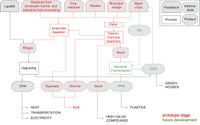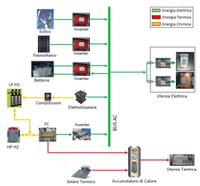Emilia-Romagna POR-FESR 2007-2013 completed Projects

BIOMASS management and utilisation
Emilia-Romagna Region Budget: EUR 160,000
Duration: 2009-2013
The EMRG activities were conducted through three lines;
Anaerobic Digestion: development of new inocula for matrices which normally have reduced yields and / or inhibitory effects on the anaerobic process:
1. degradation of ligno-cellulosic matrices (corn stalks);
2. degradation of matrices in a psychrophilic environment;
3. degradation of zootechnical residues containing high quantities of nitrogen (manure and poultry litter);
4. degradation of pyrolytic oil.
Residual biomass availability in the Emilia-Romagna Region: bio-based economy through the use of renewable, non-genetically modified, non food crop based feedstocks.
In Emilia-Romagna, the annual production of biomass from waste, residues and byproducts is estimated to be approximately 20 million tons (Mton/y)1, of which about 1 Mton/y is wood biomass from forests and forest residues. Only a small part of this important availability is used for the purpose of energy production, and an even smaller fraction of this flow of biomass is addressed to the production of high added value materials (such as polymers, resins, solvents and build- ing blocks for the synthesis of materials), or compounds which can substitute the ones entirely derived from fossil sources.
The availability of agricultural, zootechnical and agro-industrial residues has been mapped on the regional territory using GIS support.
Life Cycle Assessment: a complete qualitative approach based on knowledge of the product / process / service life cycle. The Life Cycle Assessment (LCA) has been applied on:
1. anaerobic digestion carried out on residual biomass for the production of energy from renewable resources;
2. thermochemical conversion;
3. recycling of part of the material (e.g. mineral nutrients) and the co-production of materials capable of being used for keeping soil fertility (e.g. digestate and biochar) .

Storage systems for the management of non-programmable energy sources
Province of Ravenna Budget: EUR 800,000
Duration: 2009-2013
The aim of the laboratory is to analyze the industrial potential of the micro-generation and storage systems. This research focus was chosen by virtue of the significant increase in electricity produced by non-programmable renewable sources, such as solar and wind in particular, which has taken place in recent years.
The rethinking of energy policies at various institutional levels, the consequence of increasing attention and awareness towards the issues of environmental protection and energy saving, has intensified the role of renewable sources in energy production systems.
The research activity is divided into three themes:
1) Comparative study between the different storage systems commercially available today or under development, with particular reference to electrochemical and hydrogen storage systems.
2) Design of a prototype of an integrated generation and storage system that includes the presence of an electrochemical battery, a hydrogen system and a renewable source micro-generator.
The EMRG participated in the project with the Life Cycle Assessment of the processes.